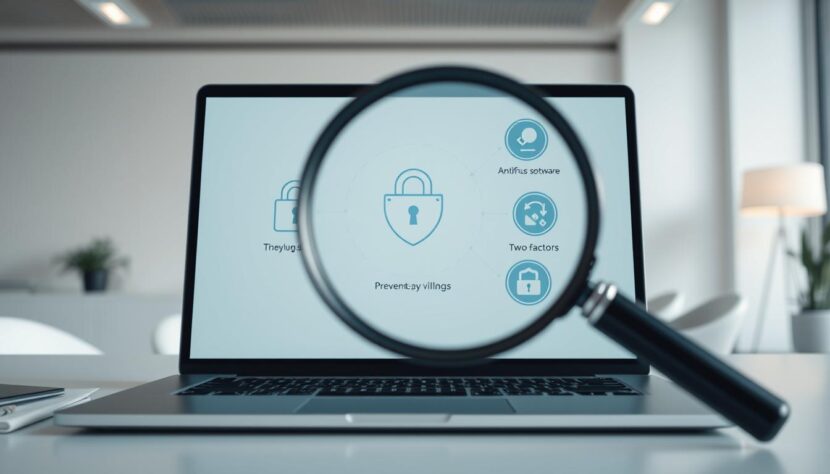Did you know over 80% of organizations faced phishing attempts last year? This shows how serious phishing scams are. They trick people into sharing personal info or downloading harmful software. Knowing how to avoid these scams is key to keeping your online world safe.
We’ll look at important ways to prevent online fraud. These tips will help you spot dangers and stay safe from scams. By being more aware and following good practices, you can lower your chances of getting caught in these traps.
Understanding Phishing: What You Need to Know
Phishing is a big problem in the world of cybersecurity. It comes in many forms. This attack tricks people into giving out personal info by pretending to be someone else.
There are a few main types of phishing attacks. Email phishing sends out messages to lots of people. Spear phishing targets specific people, using their info to trick them. Whaling is even more focused, aiming at big shots like CEOs.
Phishers use fake emails that look real to trick you. They might scare you into clicking on bad links or sharing your secrets. They also make fake websites that look like the real thing to steal your login info. Knowing how they work is key to staying safe.
Recognizing Phishing Attempts
It’s key to know how to spot phishing attempts to keep your online world safe. Start by looking out for suspicious emails. These often come from places you know but with a twist. They might say “Hello” instead of your name and ask for your login details.
Also, be careful with fake websites. They might look almost real, but there’s a difference. Look for small spelling mistakes or weird endings like “.net” instead of “.com”.
Be wary of emails that make you feel rushed. Scammers want you to act fast, which can make you overlook things. Knowing these signs can help you avoid falling into phishing traps.
| Indicator | Explanation |
|---|---|
| Generic Greetings | Emails lacking personalized information often signal potential phishing attempts. |
| Urgency | Messages that pressure you to act quickly usually indicate a scam. |
| Suspicious URLs | Check for variations in web addresses that may indicate fake websites. |
The Importance of Strong Passwords
Creating strong passwords is key in fighting phishing scams. A good password has at least 16 characters. It should mix uppercase and lowercase letters, numbers, and special symbols. This makes it hard for hackers to get into your account.
Using a password manager makes it easier to create and keep safe unique passwords. It helps you avoid using the same password everywhere. Changing your passwords often is also a good practice. This way, even if a password is stolen, it won’t be useful for long.
Strong password practices in companies help protect emails and improve overall security. Teaching people how to make and keep strong passwords is vital. By doing this, both individuals and businesses can better defend against phishing.
| Password Characteristics | Best Practices |
|---|---|
| Minimum Length of 16 Characters | Always generate lengthy passwords |
| Use of Mixed Case Letters | Combine uppercase and lowercase letters |
| Inclusion of Numbers | Incorporate numeric characters throughout |
| Special Characters | Utilize symbols such as @, #, $, % |
| Unique Passwords for Different Sites | Employ a password manager to manage different passwords |
Multi-Factor Authentication: A Must
Multi-factor authentication (MFA) is key to better online security. It asks users to show two or more proof points to get into their accounts. This could be a password, an app, or biometric data, making it harder for hackers to get in.
The benefits of MFA are obvious. It adds a strong layer of protection, making it tough for cybercriminals to get in. Even if a password is stolen, the extra steps needed to log in can stop hackers. This makes online transactions safer and builds trust.
Adding MFA to your accounts is simple but very effective. Keeping it up to date and teaching users about it boosts security even more. It’s a must in today’s digital world.

Safe Browsing Practices
It’s key to practice safe browsing to avoid phishing scams and keep your browsing secure. Look for websites with HTTPS in their URLs. This is a big step in protecting yourself from threats.
Using VPNs also boosts your security. They encrypt your internet traffic, making it hard for hackers to get your personal info. This extra protection helps keep you safe from phishing attacks.
Don’t forget to keep your web browser up to date. Updates fix security holes, reducing the risk of attacks. Staying current with security tips and being careful online makes your browsing safer.
| Safe Browsing Practice | Description |
|---|---|
| Use HTTPS Websites | Opt for sites with secure connections to protect personal data. |
| Employ VPNs | Utilize VPNs to encrypt data and enhance online privacy. |
| Update Browsers Regularly | Keep browsers updated to safeguard against security vulnerabilities. |
| Stay Aware of Phishing Tactics | Educate yourself about common scams to avoid falling for them. |
Education and Awareness
Education and awareness are key in fighting phishing. Companies should focus on phishing training for their employees. This training helps them spot threats early.
Regular training sessions teach safe online habits. This reduces the risk of falling victim to phishing. Knowing the latest phishing tricks helps users spot suspicious emails and links.
A strong cyber security culture is important too. It makes everyone in the company more alert and ready to act against phishing. When employees can report phishing, the whole company gets stronger.

| Training Type | Description | Benefits |
|---|---|---|
| Interactive Workshops | Hands-on sessions focused on identifying phishing attempts. | Improves recognition skills and fosters teamwork. |
| Online Modules | Self-paced learning covering phishing tactics and prevention. | Convenient access allows flexibility in learning. |
| Simulated Phishing Tests | Realistic phishing scenarios to assess employee responses. | Enhances readiness by identifying knowledge gaps. |
Adding these educational steps can make a company’s security much better. It also builds a culture that values cyber security.
Reporting Phishing Attempts
It’s important to act fast when you spot a phishing attempt. Reporting these scams helps keep your info safe and stops others from getting tricked. Most email services have a ‘Report Phishing’ option. Using this can really help fight phishing.
If a phishing scam targets a specific service, you should tell that service right away. Many companies have special ways to report scams. They can quickly fix their sites and keep users safe.
Telling the authorities is key to keeping everyone safe. Police and cybercrime teams need your help to track down phishing scams. By reporting scams, you help them solve crimes and keep the internet safer for everyone.
| Method of Reporting | Description |
|---|---|
| Email Provider | Use the ‘Report Phishing’ feature available in your email service. |
| Service Provider | Contact the company or service directly using their official contact methods. |
| Law Enforcement | Report phishing incidents to local authorities or cybercrime units. |
Social Media Phishing Risks
Social media platforms are popular, making them targets for phishing. It’s important to watch out for suspicious messages or friend requests. Scammers might pretend to be someone you know or a trusted brand.
To keep your accounts safe, use unique passwords and two-factor authentication. Also, adjust your privacy settings to limit who can see your information. If you fall victim to phishing, act fast.
Change your passwords right away and tell the platform about the issue. Knowing how scammers work helps you protect your data better.
Mobile Device Safety
Mobile devices are now a big part of our lives. Keeping them safe from phishing scams is very important. It’s not just about having a strong password. Using device security apps can really help by catching threats early.
Don’t forget to update your software regularly. These updates fix security holes, making it harder for hackers to get in. Always be careful with links in messages, especially from people you don’t know.
Adding device security apps to your daily routine can make protecting your phone easier. These apps scan for danger and warn you before it’s too late. Taking these steps can really help keep your phone safe from phishing.
| Smartphone Protection Methods | Benefits |
|---|---|
| Device Security Apps | Real-time threat detection and alerts |
| Regular Software Updates | Fixes vulnerabilities and enhances security |
| Cautious Clicking | Reduces risk of phishing attempts |
| Secure Wi-Fi Connections | Prevents unauthorized access to your device |
Phishing Protection Tools
Staying safe online is crucial, and using phishing protection tools is key. These tools help spot and stop phishing attacks early. It’s important to pick security software that covers all threats well. Many trusted brands offer strong phishing protection.
Keeping your security software up to date is vital. New threats pop up all the time, and old software might miss them. Make sure to update your software regularly. Also, choose something easy to use so you can quickly handle alerts.

Even with great tools, remember that no one is completely safe. The best defense is a mix of tools and being careful yourself. Learning about scams and safe browsing helps keep you secure online.
| Phishing Protection Tools | Features | Pros | Cons |
|---|---|---|---|
| McAfee | Real-time protection, Anti-phishing measures | User-friendly, Strong reputation | Can slow down system performance |
| Norton | Advanced threat detection, Regular updates | Comprehensive security suite | Higher cost compared to competitors |
| Kaspersky | Intelligent scanning, VPN features | Effective malware blocking | Occasional false positives |
| Bitdefender | Multi-layered ransomware protection | Lightweight, Fast performance | Complex setup for some features |
Case Studies: Real-World Phishing Scams
Looking at real phishing attacks shows us how scammers work and the harm they cause. In 2016, hackers tricked employees at big companies into sharing sensitive info through fake emails. This highlights the need for better training and strong security in businesses.
Studying these attacks helps companies get better at defending themselves. Knowing how hackers operate lets businesses update their security and train employees to spot scams. This makes companies safer and builds a culture of security.
Also, these studies show how crucial ongoing cybersecurity education is. Keeping teams updated and practicing helps them spot threats. This reduces the risk of falling for phishing scams.
Creating a Phishing Response Plan
Creating a strong phishing response plan is key for any company. It helps manage and lessen the harm from phishing attacks. A clear plan outlines what to do first and who does it, ensuring quick action when needed.
It’s important to have training for responses often. Training should teach teams how to spot and handle phishing attempts. Regular practice and updates keep everyone ready for new threats.
Listening to team feedback after training makes the plan better. Regularly checking and updating the plan helps companies stay ready for new challenges. This keeps the plan strong and effective against phishing threats.

Staying Informed
Keeping up with cybersecurity news is key to avoiding phishing scams. Following trusted sources helps you learn about new threats and tactics. This way, you can spot and dodge phishing attempts early on.
Joining online communities focused on cybersecurity is also beneficial. These groups share knowledge and tips, helping everyone stay safe. You can learn a lot from others who face similar challenges.
Don’t forget about webinars and workshops on cybersecurity. They cover the latest ways to protect your info. Learning through these events keeps you informed and helps you stay safe online.


